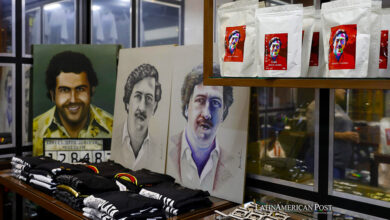Latin America’s Battle Against Rising Child Obesity and Sugary Drink Consumption

The consumption of sugar-sweetened beverages among children has surged in Latin America over recent decades, paralleling a concerning rise in child obesity rates. A new global study sheds light on these trends, urging the region to take decisive action to safeguard future generations.
In the past three decades, the global intake of sugar-sweetened beverages (SSBs) has soared, particularly among children. This trend is alarming in Latin America, where consumption levels have reached some of the highest in the world. The correlation between this surge and the rising rates of child obesity cannot be ignored. According to a comprehensive study published in The BMJ, children worldwide are consuming more sugary drinks than ever before, with a marked increase in Latin America, leading to a public health crisis that demands urgent attention.
The study, conducted by an international team of researchers from the United States, Greece, Canada, and Mexico, analyzed data from 185 countries over 30 years. It revealed that in 2018, children consumed an average of 3.6 servings of sugary drinks per week—a 22.9 percent increase from 1990. This rise in sugary drink consumption among children has been much steeper than among adults, signaling a significant public health concern.
Dariush Mozaffarian, the study’s senior author and director of the Food is Medicine Institute at Tufts University, emphasized the gravity of the findings: “Our findings should raise alarm bells in nearly every nation worldwide.” The study highlighted that the surge in sugary drink consumption has gone hand in hand with a sharp increase in child obesity rates, which now affect approximately 160 million children and teenagers globally.
Latin America’s Struggle
With its rich cultural heritage and diverse food traditions, Latin America has become a battleground in the fight against child obesity. The region has witnessed some of the highest levels of sugary drink consumption globally, with an average of 9.1 servings per week per child in 2018. This is significantly higher than in other parts of the world, and the consequences are evident in the rising obesity rates among the region’s youth.
Interestingly, the study noted that while sugary drink consumption in Latin America and the Caribbean was slightly lower in 2018 than in 1990, the overall trend has been far from steady. The 1990s and early 2000s saw a decline in consumption, likely due to economic challenges and the emergence of health campaigns promoting better dietary habits. However, the more recent uptick in sugary drink intake can be attributed to the region’s economic growth, aggressive marketing by multinational corporations, and inconsistent regulatory efforts to curb the consumption of these beverages.
“The influence of multinational corporations responsible for ultra-processed foods, marketing strategies targeted at young people, lack of (or poor) regulatory measures to limit the intake of SSBs have also been consistently observed in Latin America and other regions with improving economies,” the researchers noted. This underscores the complex interplay between economic development, corporate influence, and public health, making it challenging to implement effective interventions.
The Role of Multinational Corporations
As Latin America’s economies have grown, so too has the power and reach of multinational food and beverage corporations. These companies have capitalized on the region’s expanding middle class, which has more disposable income and is increasingly drawn to Western-style diets that include sugary drinks. The aggressive marketing tactics these corporations employ, particularly towards children, have made sugary drinks a staple in many households across the region.
One of the most significant challenges in combating the rise of sugary drink consumption in Latin America is the lack of stringent regulations on advertising and the availability of these products. While some countries have introduced taxes on sugary beverages and implemented labeling regulations, these measures are often met with strong opposition from the beverage industry. The industry’s lobbying efforts have been effective in delaying or diluting such policies, leaving many children vulnerable to the adverse health effects of excessive sugar consumption.
The study also highlighted that in many lower-income countries, including Latin America, sugary drinks are often perceived as a status symbol—a marker of affluence and modernity. This perception is powerful in urban areas, where higher-income families are more likely to purchase these beverages. In contrast, in high-income countries, sugary drinks are increasingly considered unhealthy, leading to a decline in consumption among more affluent populations.
“It’s a question of affordability,” explained Dr. Berthold Koletzko, a pediatrics professor at Ludwig Maximilian University of Munich and president of the European Academy of Pediatrics. He pointed out that in many lower-income regions, sugary drinks are more accessible and affordable than healthier alternatives, making them an attractive option for families.
Mexico: The Epicenter of the Sugary Drink Epidemic
Among the 185 countries analyzed in the study, Mexico emerged as a particularly concerning case. In 2018, Mexican children consumed an average of 10.1 servings of sugary drinks per week, the highest rate among the 25 most populous countries for children. This staggering statistic highlights the urgent need for intervention in a country where sugary drinks have become deeply ingrained in the national diet.
Mexico’s high sugary drink consumption is not a new phenomenon. The country has long been one of the world’s largest consumers of sugary beverages, with brands like Coca-Cola becoming almost synonymous with daily life. The health consequences of this addiction are severe: Mexico has some of the highest rates of obesity and type 2 diabetes in the world, and these issues are increasingly affecting children.
The Mexican government has taken steps to address the problem, including introducing a tax on sugary drinks in 2014 and warning labels on unhealthy foods and beverages. These measures have had some success in reducing consumption, particularly among lower-income populations. However, the overall impact has been limited, and the country continues to grapple with the public health crisis fueled by sugary drinks.
“The intakes and trends we’re seeing pose a significant threat to public health, one we can and must address for the future of a healthier population,” said Laura Lara-Castor, the study’s first author and a postdoctoral researcher at the University of Washington. The situation in Mexico underscores the need for sustained efforts and more robust policies to reduce sugary drink consumption and promote healthier alternatives.
Policy Interventions and Public Awareness
The study’s findings highlight the critical need for targeted education and policy interventions to curb the rising consumption of sugary drinks among children, particularly in Latin America. Experts agree that a multifaceted approach is required to address the issue effectively. This includes implementing taxes on sugary beverages, regulating advertising and labeling, and promoting healthier dietary habits through public education campaigns.
One of the most effective strategies identified in the study is imposing taxes on sugary drinks. Evidence from countries like Mexico suggests that such taxes can significantly reduce consumption, particularly among low-income households. However, to maximize the impact of these taxes, they must be complemented by other measures, such as subsidies for healthier alternatives and investments in public health education.
Another critical area for intervention is the regulation of marketing practices targeting children. In many Latin American countries, children are bombarded with advertisements for sugary drinks on television and online. These ads often feature popular cartoon characters or sports celebrities, making them particularly appealing to young audiences. Governments must enforce stricter regulations on how sugary drinks are advertised and sold to protect children from these marketing tactics.
Schools also play a crucial role in shaping children’s dietary habits. By limiting the availability of sugary drinks in schools and providing healthier options, educators can help instill better eating habits from a young age. Additionally, school-based programs that teach children about the dangers of excessive sugar consumption and the benefits of a balanced diet can empower them to make healthier choices.
Finally, public awareness campaigns are essential to changing societal attitudes towards sugary drinks. In many Latin American countries, sugary drinks are still seen as a regular part of daily life, and the health risks associated with their consumption are not widely understood. Governments and public health organizations can help shift public perceptions and reduce demand for these harmful products by raising awareness about the dangers of sugary drinks and promoting healthier alternatives.
The study’s findings paint a sobering picture of the impact of sugary drink consumption on child health in Latin America. As the region continues to grapple with rising obesity rates and the associated health risks, it is clear that urgent action is needed to reverse these trends. Policymakers, health professionals, and the public must come together to implement effective strategies that protect the health of future generations.
Also read: A Mexican Scientist’s Fight Against Rare Genetic Disease
The challenge is significant but not insurmountable. By taking bold steps to reduce the consumption of sugary drinks and promote healthier lifestyles, Latin America can turn the tide on the child obesity epidemic. The stakes are high, but the potential rewards—a healthier, more vibrant population—are well worth the effort.





